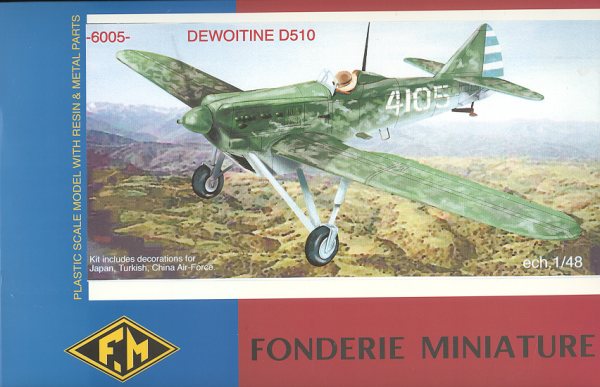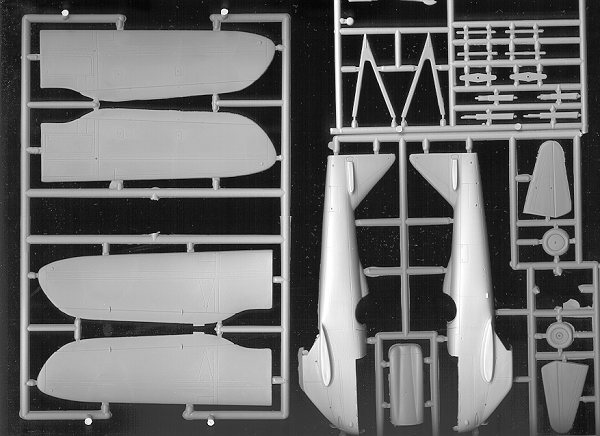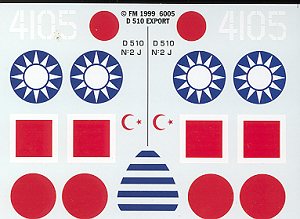
| KIT: | Fonderie Miniatures 1/48 Dewoitine 510 |
| KIT # | 6005 |
| PRICE: | $34.95 |
| DECALS: | See review |
| REVIEW & | |
| NOTES: | Multi-media short run kit |

| HISTORY |
The D.510 is an improvement over the very similar D.501. Likeits siblings, it had a wide track undercarriage and was pleasant to fly.Improvements were a more powerful engine and a three bladed metal propeller aswell as a larger tail from the earlier versions. 118 were built, most going tothe French Air Force, where it entered service in 1936. However, a number ofthem were sold to other countries.
The biggest order was for 24 aircraft from China, which at thetime was in real need for aircraft in it's fight against the Japanese (as wellas each other). Single examples were bought by Great Britain and the SovietUnion while Japan bought two. The biggest order was from Turkey who ordered 36and wanted to build 30 under license. However, interest waned and the order wasnever fulfilled. Some aircraft were sent to Turkey, while others found their wayto Spain for use in the Spanish Civil War.
| THE KIT |

 Not sure if thisis the same model as produced by Hit Kit, but the molding is similar to theirMystere IV. This is a true multi-media kit with parts in styrene, etched metal,cast metal, resin and vacuformed plastic! It seems like the modeler couldeasily build either of the earlier versions as there is a two bladed wooden propincluded with the kit, though the rudder would have to be somewhat modified orperhaps replaced with sheet styrene.
Not sure if thisis the same model as produced by Hit Kit, but the molding is similar to theirMystere IV. This is a true multi-media kit with parts in styrene, etched metal,cast metal, resin and vacuformed plastic! It seems like the modeler couldeasily build either of the earlier versions as there is a two bladed wooden propincluded with the kit, though the rudder would have to be somewhat modified orperhaps replaced with sheet styrene.
Just to give you an idea of what is made of what, the vacuformedpiece is the seat; resin is used for the prop spinner, under fuselagepiece, wheel spats, rudder, radiator, and fuel tank. Much of the cockpit isetched metal. The cast metal is used for both props and a few air scoops.
The rest of the kit is in low pressure injected plastic. Detaillooks quite good. Most of the parts have some flash on them and the mold linesare a bit thick, but that is typical of the genre. A nice touch is the alreadyflattened tires. The wings and tailplanes are butt joined. Struts do not haveprominent placement markings so that should be fun.
The instructions are three steps showing a general placement ofparts. A few parts, like the prop shaft, tailplane struts, exhaust stacks, andguns will have to be made from sprue. No part painting guide is given. There isa decal placement guide for the three aircraft and only colors for the outsideof the aircraft are given.
Decals are for three aircraft. It appears that the standardpaint for the planes was pale blue. I say this as the schemes listed as 'sanscamouflage' list a pale blue and show Tamiya XF-23 or Humbrol 65 as the color.This is the scheme for the Japanese and the Turkish aircraft. Frankly, I thoughtthose would  be in bare metal oraluminum paint. The third scheme is the same as on the box top and that is aChinese aircraft which includes Tamiya XF-61 or Humbrol 30 mottling over theupper surfaces.
be in bare metal oraluminum paint. The third scheme is the same as on the box top and that is aChinese aircraft which includes Tamiya XF-61 or Humbrol 30 mottling over theupper surfaces.
Decals look to be usable and are glossy. However, the whiteappears to be rather transparent as they are barely visible against the lightblue backing sheet. For those who are brave, the similar D.501 was sold toLithuania so there is an alternate marking opportunity. I doubt if there willever be an aftermarket sheet for this one!!
Well there it is. An interesting subject that will undoubtedlytake a bit of skill and patience to complete. One thing for sure, it will drawcomments when you show it.
Review copy courtesy of me and my wallet!
If you would like your product reviewed fairly and fairly quickly by asite that has over 1,100 visits a day, please contactme or see other details in the